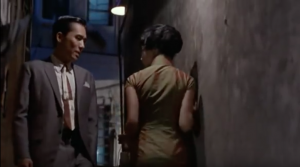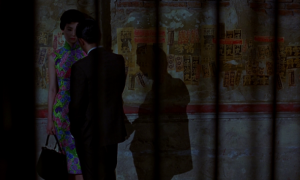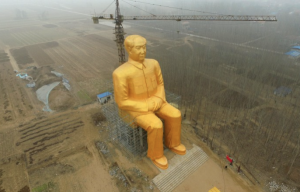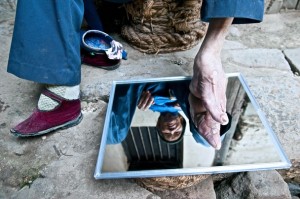

In her piece, “Surface, Fabric, Weave: The Fashioned World of Wong Kar-Wai,” Giuliana Bruno discusses how costume design in “In The Mood For Love” is a deliberately aesthetic choice as a complement to the surrounding set. Fashion, color, and texture act as a subconscious means of creating moods and feelings within the audience. In the above mis en scenes, film producers in “In The Mood For Love” uses two different Qipaos to reflect main character, Maggie’s, emotions to the audience. In the first scene, Maggie somberly retrieves noodles from a noodle bar in a mute-toned qipao in which she runs into her neighbor. Later in the film, Maggie accompanies her neighbor to dinner in a quote differently styled qipao; one of bright colors and patterns.
The images exemplify how fashion aesthetics act as an art form to engage space and color in the film to depict the mood of the character within the scene. When viewing the above mis en scenes in “The Mood For Love,” one can compare differences between the two photos through their similarities in an attempt to determine the mood of the scene.
Qipao:
- Scene 1- In the first mis en scene Maggie wears a qipao of subdued colors that reflect a sense of loneliness and withdrawal. Maggie lethargically meanders into the takeout noodle bar, and though she appears graceful and walks steadfast, the qipao she wears tells the story of pain and a cheating husband. No words are spoken in this scene, however the color of the qipao successfully exudes Maggie’s present mood as one forlornness and dull heartache.
- Scene 2- In the second scene, Maggie’s qipao is bright, almost neon, and patterned. Though Maggie again ventures to eat noodles, the mood is more energetic than the aforementioned scene. Maggie’s dress reflects a zealousness that was absent in the 1st scene, as new romance makes her more spirited and lively.
The Male Figure:
- Scene 1- The male figure, Maggie’s neighbor and love interest, is a key similarity in both scenes. In the first scene, the two are just meeting, and an impeding connection is felt between the pair. They both exude a similar sadness in this scene that foreshadows their attraction.
- Scene 2- Maggie’s love interest is closer to Maggie in this scene, and his body is now faced toward hers, suggesting an opening up of emotions and deepening of their relationship. Similar to clothing, body language acts as an aesthetic art form that displays unseen thoughts of the characters or rather, their inner feelings.
Space and Texture (Wall):
- Scene 1- Maggie, in her neutral qipao, becomes “one” with a plain, dark wall, blending into its shadows. This suggests that Maggie has fallen into the shadows and textures of the wall in a mood of somberness. She cowers slightly into the wall, but despite her camouflaging, Maggie still makes a connection with her love interest.
- Scene 2- Again, Maggie matches the wall behind her, however, this wall is colorful and flashy; a kaleidoscope of more vivid and vibrant emotions. She does not cower against the wall in this scene, but outshines it in its exuberance. This greater suggests how Maggie’s mood has transformed and become brighter as her relationship has flourished.
In conclusion, the constants in these scenes (clothing, man, wall) reflect how Maggie’s inner emotions and mood have grown and transformed as her relationship has become more in depth throughout the passage of time.
well analyzed sequence and persuasive connotations




